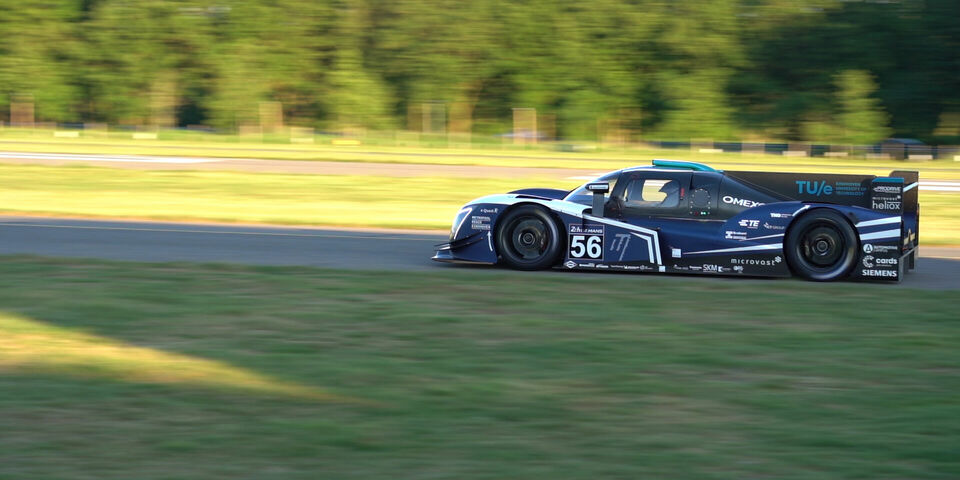InMotion’s electric race car takes to the track
The electric race car of student team InMotion not only has to be able to charge extremely fast, it also has to race safely and very fast. To that end, the team took their car, The Revolution, to Breda International Airport last month to perform a number of driving tests, preparing themselves for the real thing at racetracks like Circuit Zandvoort. An error during one of the tests threw a spanner in the works, but ultimately, it was not an insuperable problem.
Small planes are taking off and landing at Breda International Airport, a small airport located between Breda and Roosendaal. Under cover of a tent on the site, electric race car The Revolution is charging. Meanwhile, the members of the InMotion team are looking at the graphs from last day’s driving tests, which show engine temperatures, among other things. It’s one of the categories the team wants to test the electric race car on these days. The engine and the battery pack must not overheat.
The tests are all about the car’s drivability. It is something that InMotion on a day-to-day basis is less concerned with. The team is working towards participating in car races and dreams of competing in the 24-hours race of Le Mans, but does that mainly to showcase the potential of fast charging. The goal is to reduce the charging time as much as possible, thereby making the electric race car suited for long-distance racing. The car’s current charging time for going from twenty to eighty percent is twelve minutes, says Thomas Kuijpers, technical manager of InMotion: “But we want to bring that down even more this year, to only a few minutes.” To ensure that the battery can handle those charging times, it needs to be thoroughly cooled, he explains. “We currently cool the battery cells at module level. There are twelve battery cells in such a module, but we’re working on a way to cool all those cells individually.”
Sweet spot
Still, you have no use for a fast-charging car if you cannot use it on a race track, which is why InMotion has now taken The Revolution to the airport. “We’re validating the functionality, making sure it can drive safely and that the car feels good to the driver. And we’re testing different driving strategies that can prevent the powertrain from overheating”, Kuijpers says. This evening, the team, along with professional rally driver Kevin Abbring, will be looking for the so-called sweet spot: the highest possible power level at which the car can still remain at a good temperature. During the first drive of the evening, the limit of 140 degrees Celsius is already reached.
The team seems to have an idea of what the ideal power level is. To see if they are right, Abbring gets back into the car. But he doesn’t get very far. At the very first corner, a red light comes on, indicating that there is high voltage on the car. He stops and has to jump on a mat outside the car. The team members in the tent are quite shaken up and start implementing safety protocols. An attempt to restart the car results in another error, making it too dangerous to drive it back to the tent. When measurements show that there is no high voltage on the chassis, the safety car drags the vehicle back to its spot.
Undesired conduction
There, the team members find out that the problem probably lies in the engine, says team manager Ewout Timmermans afterwards. “The next day, we discovered that the coolant had leaked and it had caused an undesired conduction in the engines. It turned out that the situation had never been very dangerous, but the engines were no longer working.” Hence, there was no more racing for the rest of the week. Instead, the team took the car apart and took the engines to the manufacturer in Switzerland. “There, they applied a new seal, so the coolant couldn’t leak anymore,” Timmermans says.
Two weeks after the error, the car is back on track at Breda airport. And just one day later at Circuit Zandvoort. “That was one of the main goals in the end, to perform tests at Zandvoort and shoot some nice footage. And we made that happen,” says Timmermans. But the engines keep heating up, at the racing circuit as well, he says. “So there’s still a lot of room for improvement there, but now we have the data we need in order to work on that.”
On the 12th of July, InMotion will present the race car on campus, with a big event.


Discussion